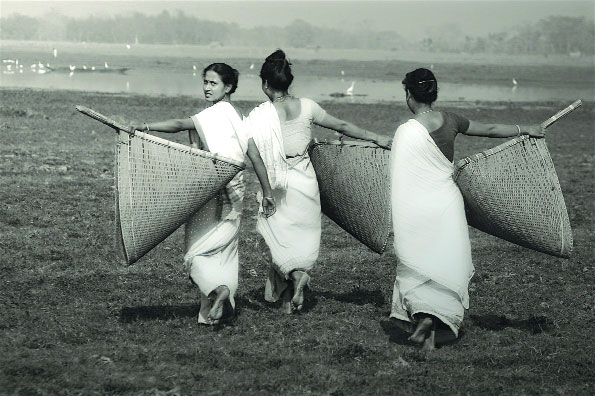Photographer Prabir Purkayastha captures ancient Assamese culture from his village as he strongly feels the need to record and preserve them for future generations to see. By Uma Nair
More than 20 years ago, photographer Prabir Purkayastha of Ladakh fame started capturing his village in Assam. Verdant virgin forests shimmered under the monsoon clouds, the sun rays sometimes glistening like an age-old green velvet lining in a jewellery box — the forests in his village had vanishing sounds coupled with a simple lifestyle.
Prabir reminisces, “In 2004, I visited my mother’s village Rampur, Assam, after almost 40 years. I was amazed by the unique tapestry of life that I witnessed and was a part of. As a child, I had heard my mother’s ‘fairy-tale’ stories of her village and of my ancestors who had founded Rampur almost 200 years ago. Sadly, I realised that this ancient and secluded way of life was slowly, but surely, ebbing from this world.”
His photographs of an Assamese voyage seems eternal. During the past two decades, Prabir has journeyed endlessly through the landscape and villages of Assam, which lies at the northeastern tip and captured powerful images of the rare bastions of ancient Assamese culture. The powerful images of the landscape, sometimes juxtaposed with people, are passionately crafted. They speak volumes of a magical way of life which has changed little through the centuries.
Dagaur Pukoor: Death of water
It is this age-old tapestry that Prabir reverently reveals and calls Dagaur Pukoor.
“Photographed over 12 years, Dagaur Pukoor is one such fairy-tale,” explains Prabir.
“All the images were created within the expressive texture of natural elements like rain, sunshine, water and mist. Every step of this journey was brutally challenging — from the very beginning till the last frame. The challenge of how to accomplish the specific imagery I wanted left me numb, especially since I was creating these images with a great sense of intimacy and in a rather secretive way. The pleasure of discovery at the start of my project and the euphoric feeling of depletion, at it’s completion, was just the same. Then it dawned upon me that Dagaur Pukoor was the answer to the prayers of the remote rural fishing community. And this outrageously spirited and generous mystical lake had for countless decades nourished and helped all those who sought sustenance within her. No pilgrim to her shores ever returned empty handed,” says Prabir.
He adds, “I don’t know how privileged I was to tell the story of these sacred waters and the gift of grace, of life nourishing life. I just wish that someday, in some other world, I can tell my ancestors this story. It’s beautiful.”
Fish and Bamboo
A bamboo-woven roof thatch stands on the wayside while small fish are left to dry in the monsoon days. The image comments on the architecture that has been common in this region of seismic shifts.
“The phuti maach’ (small fish) was meant for the personal meals of the fishermen and their families. It’s an ancient practice to dry the fish on a bamboo platform that has been used by generations of this fishing community,” explains Prabir.
Another realm
Prabir frames a meditative study of an Assam that he loves and continually tries to understand. “Assam connects me to my childhood and my people. It connects with me at a very emotional and spiritual level. I can spend a lifetime here,” says the photographer.
In this collection, his photographs occupies the interstitial space between documentation and the more expressive and imaginative arts. The lone fisherman in his canoe seems to be from another world, who holds the tangible warmth of human presence.
In another image, an old lady in the forest with a rimmed hat woven through straw is a testimony of beauty. It vividly shows how the people themselves seem inseparable from the shadows and topography that frames them. The silhouette of a lady with her baby swung on her back looks theatrical. The three harvesters are imbued with an air of grace, ancient wisdom and rootedness. It appears to hold a secret waiting to be discovered as one turns back and looks into the frame.
Posterity
“I have always believed that a photographer captures something for posterity. We cannot be dumb witnesses to the vagaries of change. For me, my village holds a resonance that lives through its cultural fabric and its geological facets. For some inexplicable reason, I can’t see myself as just another mute spectator pretending that the little nooks and corners of life never existed,” he says.
For him, change is the key to living. He adds, “While capturing these images, I knew I was helplessly watching communities slowly getting vanished into the dusty corners of our nation’s history. But I felt strongly about the fact that something needs to be done to record and preserve what I see for the future generations.”


























